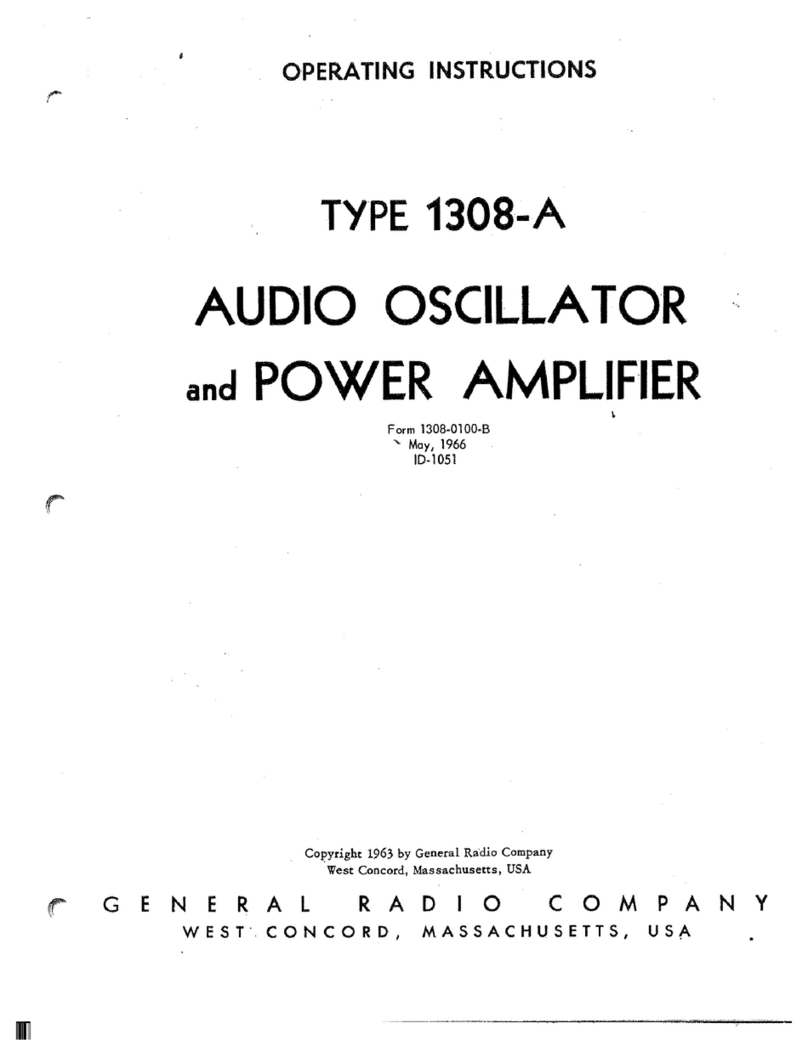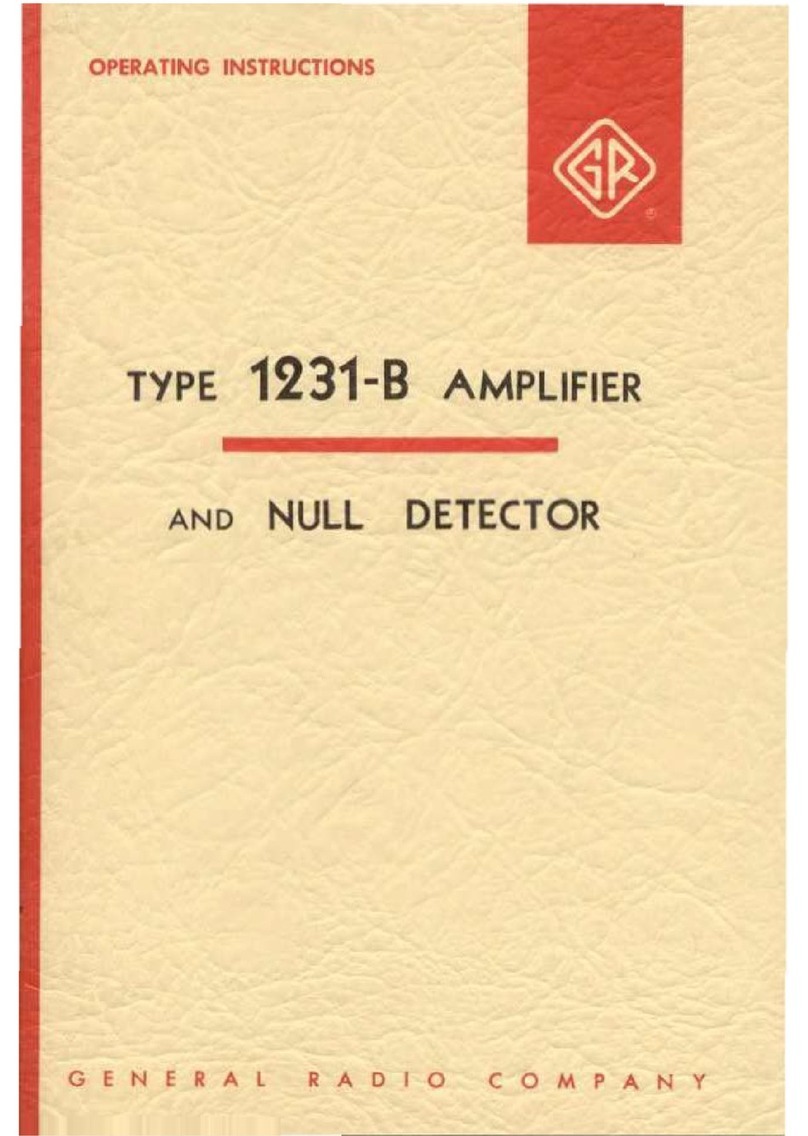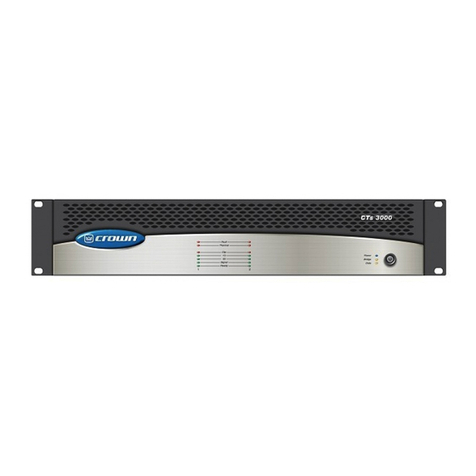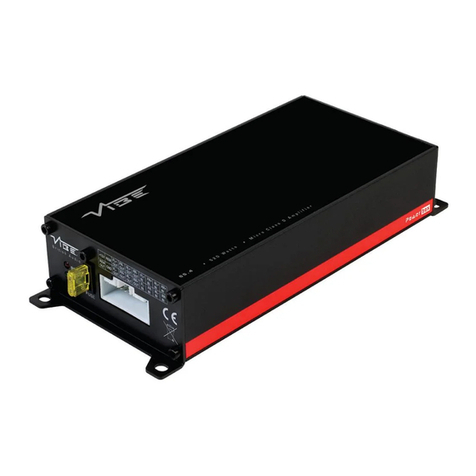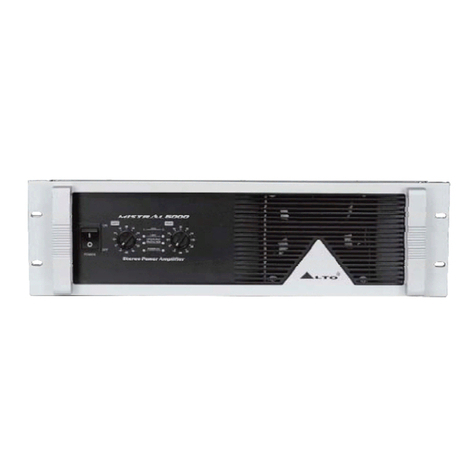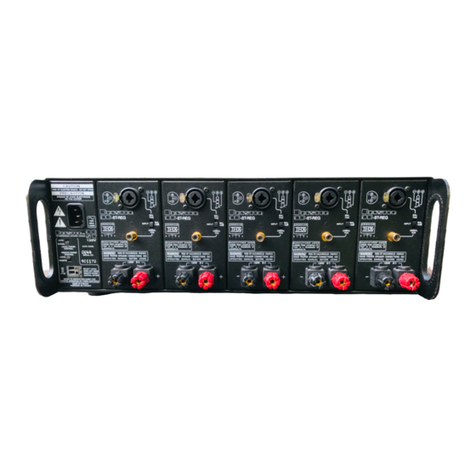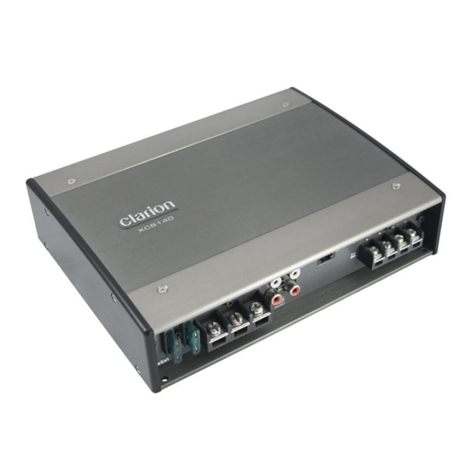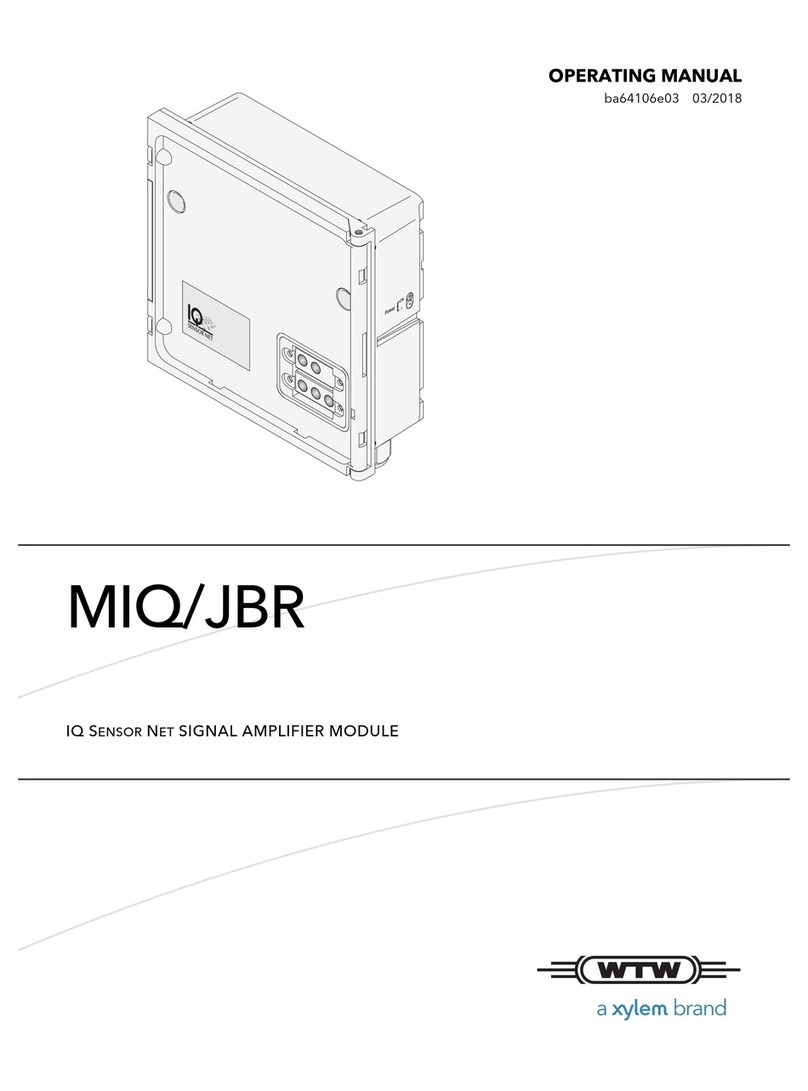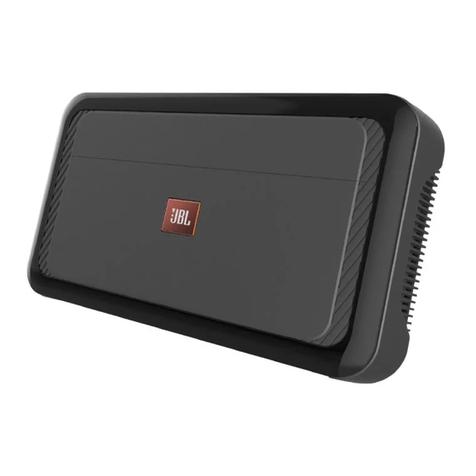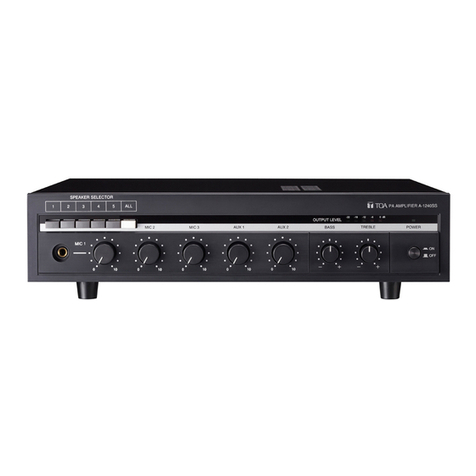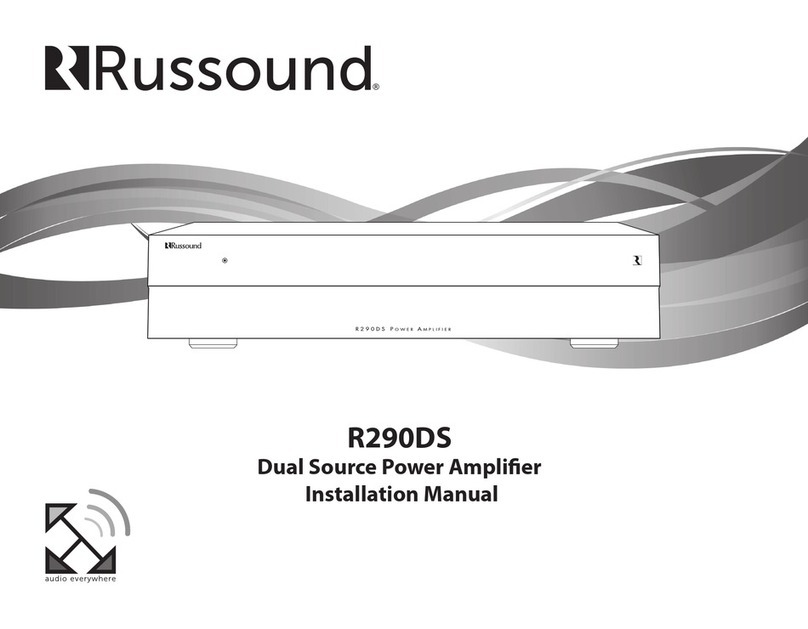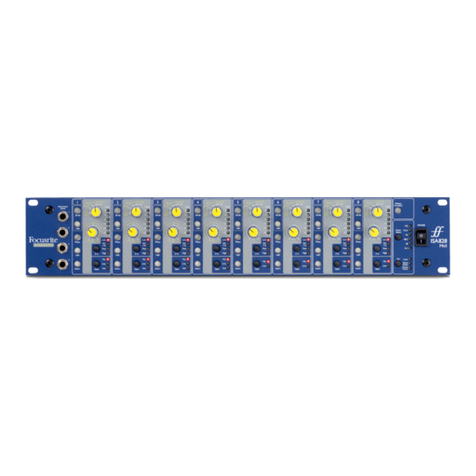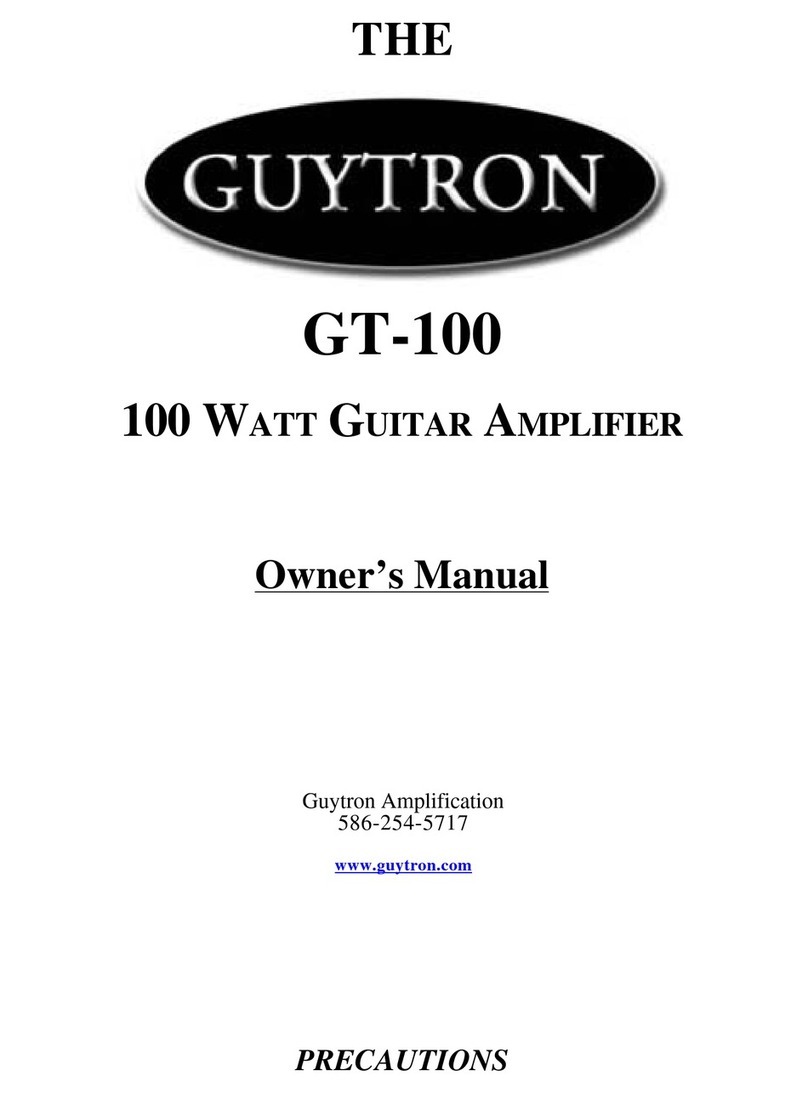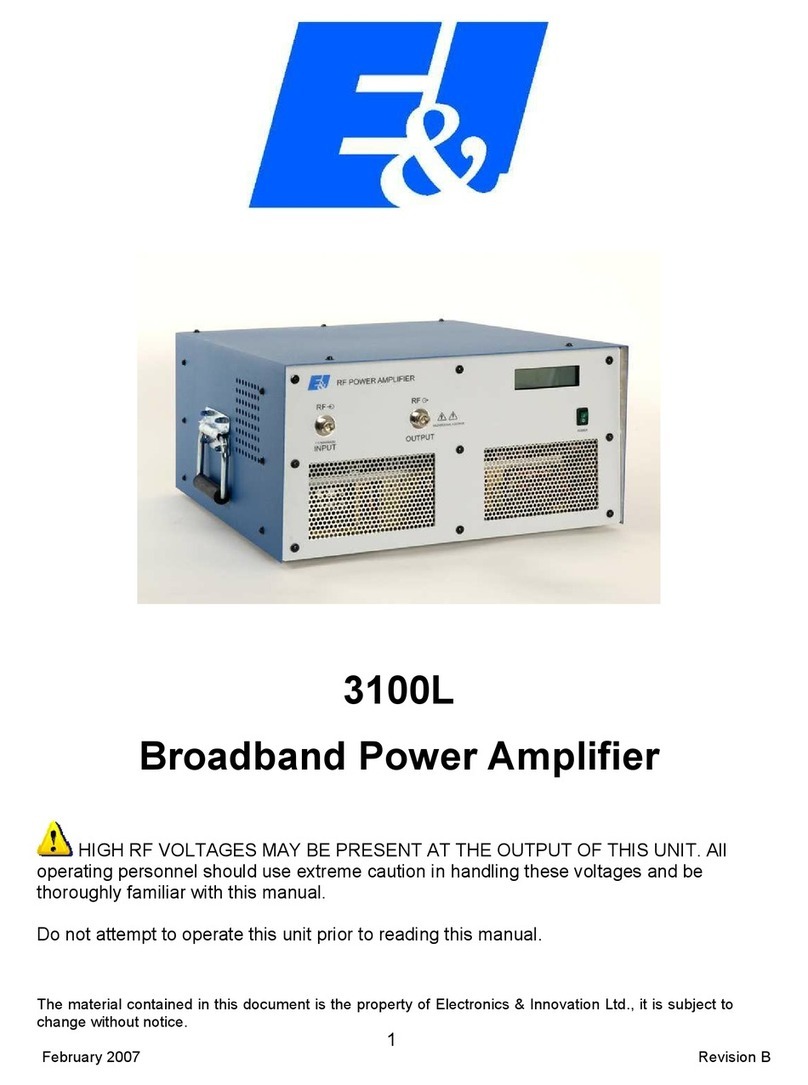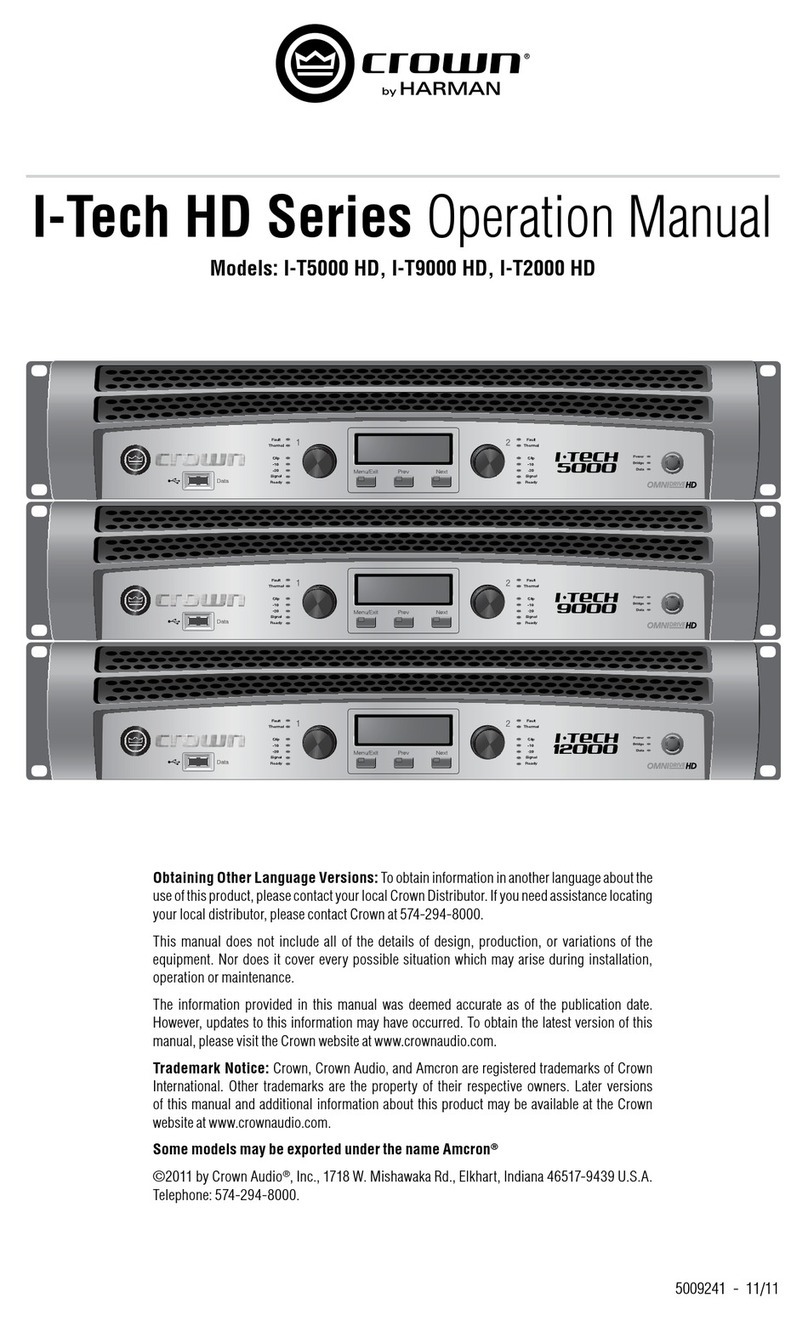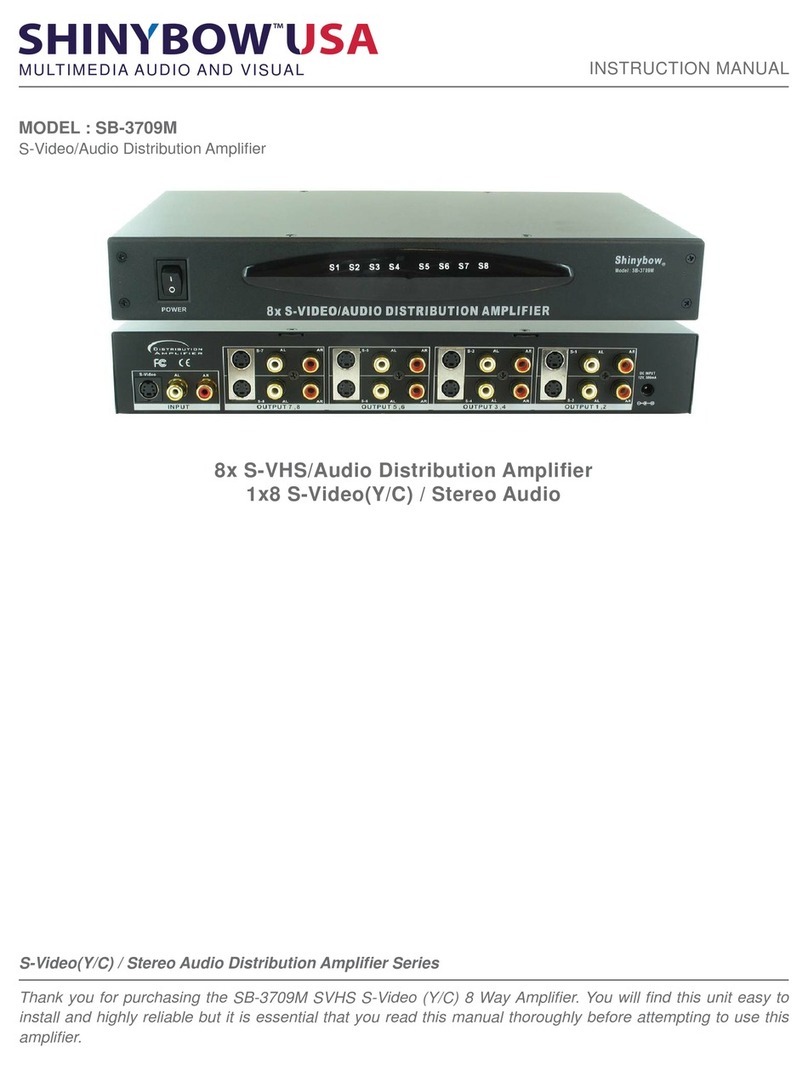GENERAL RADIO COMPANY 1233-A User manual

·""
'
./,
.....
-?
OPERATING
INSTRUCTIONS
··
~
TYPE
1233-A
POWER
AMPLIFIER
GENERAL
RADIO
COMPANY
D

OPERATING INSTRUCTIONS
TYPE
1233-A
POWER
AMPLIFIER
Form
1233-0100-D
November,
1962
GENERAL
RADIO
COMPANY
WEST
CONCORD,
MASSACHUSETTS,
USA

Panel View of the Type 1233-A Power Amplifier
SPECIFICATIONS
INPUT VOLTAGE:
Less
than
0.2
volt
for
full output.
INPUT IMPEDANCE: 100,000
ohms
in
par-
allel:
with
37
pf
(grounded).
POWER SUPPLY: 105 to 125
(or
210 to 250)
volts,
40 to 60
cps;
120
watts
at
zero
output;
140
watts
maximum.
Instrument
will
operate
with
a
maximum
output of
10watts
on
power-supply
frequen-
cies
up
to
400
cycles.
VOLTMETER:
Full
-wave
-
average
type;
150, 50, and 15
volts
f.s.;
Accuracy
±5%,
compensated
to 3 Me.
FREQUENCY RESPONSE: See
plot,
page
8.
PHASE SHIFT: See
plot,
page
8.
Range Switch
Poaitiun
'tOcto'tOkc
'tO
kc
to
1.5
Me
Operating
Freq. Range
'tOe-
'tOke
50c-15
kc
't0kc
-
1.5Mc
't0kc
-
0.5Mc
OUTPUT
Power* Voltage
8 watts
15
watts
8
watts
15
watts
TUBE COMPLEMENT: 2
-6AC7
2
-807
2
-6AG7
1-6]6
TERMINALS: Input
and
output, Type 874
LockingCoaxial
Terminals
with
ground
post
for
double-plug
connection:
Type
938 Binding
Posts
for
balanced
output.
ACCESSORIES SUPPLIED: Two
Type
274-
MB
Double Plugs; two Type 874-C58A
Cable
Connectors;
two
spare
line
fuses,
Type
CAP-22 Power
Cord.
DIMENSIONS: Width 19
3/8,
height
7
1/2
,
depth
15
1/2
'
inches
(495
by
190 by 395
mm)
over-all.
NET WEIGHT:
46
1/2
pounds, (21.5 kg).
U.S.
Patent Nos. 2,548,457; D187,740
Optimum Load
Impedance
600
or
1500
500 grounded
Rise
Ti
me
Distortion
at Rated
01dput
3%
S%
Noise
Level
60
db
below
15
watts, or equiv·
alent to
'tOO
pv
input.
70
db
below
15
watts
or
equivalent
to
63
pv input.
'tOctoSMc
'tOe - S Me
150
volts
, CRO deflec- 0.1 0.6V, peak to peak,
bal,
or
equivalent
to 600 pv peak-
to-peak
input
.
Disconnected
peak-to-peak
lion plates; 1 psec.
bal; 50
volt
~
Mil, 36• leads
grounded
Any single fre-
15
watts, with external tuned
output
transformer
quency,
'tO
c
to
5Mc
•
Rated
output is obtainable
at
105
volts line; output is greater
for
higher line voltages.

OPERATING
INSTRUCTIONS
For
TYPE
1233-A
POWER
AMPLIFIER
SECTION 1.0 DESCRIPTION
1.1
PURPOSE
The Type 1233-A Power Amplifier was designed
for
use
with a
low-level
signal
source
to
provide
a
moderate
amount
of
power
output within
its
fre-
quency
range.
The
circuit
is
arranged
to
provide
maximum
flexibility
for
general
purpose
application.
For
example,
at
one position
of
the output
switch
the Type 1233-A functions
as
a
wide-range
oscilloscope-deflection
amplifier.
A
particular
feature
of the Type 1233-A
is
an
aperiodic
frequency
range
pro-
viding
appreciable
power
output up
to
1.5
Me.
1.2 FREQUENCY RANGE, POWER OUTPUT,
AND
LOAD
IMPEDANCE
The
Type
1233-A
Power
Amplifier
is
arranged
to
operate
over
three
frequency
ranges
as
selected
by
the
output
switch.
1.21
20
Cycles
to
20
Kilocycles
Range:
The
rated
power
output
from
50
cycles
to
15
kilocycles
is
15
watts.
The
output
is
available
for
balanced
or
grounded,
600-
or
150-ohm
loads,
as
selected
by
the
output
switch.
At
20
cycles
and
20
kilocycles
the
rated
power
output
drops
to
8
watts.
1.22
20
Kilocycles to 1.5 Me Range: The
rated
power output
from
20
kilo-
cycles
to
0.5 Me
is
15
watts
into a 50-ohm load, dropping
to
8
watts
at
1.5
Me.
1.23
20
Cycles
to 3 Me Range:
This
output
is
balanced
to
ground
and
up
to
150 volts peak to peak
is
available with a high-impedance load.
The
voltage
gain
is
approximately
60
db.
1.3 INPUT VOLTAGE
AND
IMPEDANCE
Less
than
0.2
volt
at
the input
is
required
to
produce
full
output.
The
input
impedance
is
equivalent
to
100,000
ohms
in
parallel
with
37JJ.JJ.f.
c
<
<
<
<
c
c
c
c
c
c
c
c

GENERAL
RADIO
COMPANY
1.4 OUTPUT VOLTMETER
The
output
voltmeter
indicates
terminal
voltage and
is
provided with
full-scale
ranges
of 150,
50
and 15
volts.
The
meter
can
also
be switched
to indicate the
plate
current
of
the output
amplifier
tubes.
SECTION 2.0 OPERATION
2.1 CONTROLS
The
controls
consist
of the following: OFF-ON switch with pilot light,
an
OUTPUT
range
selector
and a METER
RANGE
switch.
2.2 TERMINALS
Type 874 Coaxial Connectors
are
provided
at
the INPUT and OUTPUT.
Ground binding
posts
at
3/4-inch
spacing with
the
center
conductor of
these
connectors
permit
connection
to
be
made
also
by
means
of Type 274-MB
Double Plugs if desired. Two insulated binding
posts
are
provided
at
the
out-
put, which
are
used when
BALANCED
output
is
selected. The 115v/230v, 40-60
cycle line
cord
receptacle
is
on the back of the
instrument.
2.3 FUSES
The
line
fuses
are
on the back of the
instrument.
Two-ampere
Slow-
Blow type
are
used
for
115-volt operation.
One-ampere
Slow-Blow type
are
used for 230-volt operation.
2.4 INSTALLATION
The panel
is
designed
for
mounting in a 19-inch
relay
rack, but
remov-
able end
frames
are
supplied
so
that the
instrument
can
be
used
equally well
on
a table.
In
either
case
ventilation should not be appreciably
restricted
or
overheating
may
result.
If
possible
the
space
immediately
above the Type
1233-A should be kept
free
of
other
instruments,
and any
instruments
below
should not produce
large
amounts of heat.
2.5 OPERATION
The
essential
operating information
is
contained in the engraving of the
OUTPUT
range
selector.
2.51
~:
Less
than 0.2 volts
are
required
at
the INPUT to produce full
output in
all
cases.
2.52 Load
Resistance:
For
proper
operation
the load should
match
the
value engraved
at
the
desired
setting of the range
selector
.
For
loads
differ-
ing in value
from
those
provided
an
external
matching
transformer
may
be
used
if maximum output
is
desired
with low
distortion.
2

TYPE
1233-A POWER AMPLIFIER
2.53 Output:
To
keep
distortion
low the output voltage should
be
limited
to
a value
representing
rated
power output into the indicated load
resistance.
R-M-S
POWER LOAD RESISTANCE VOLTAGE
watts ohms
15
600
95
15
150
47.5
15
50
27.4
8
600
69.3
8
150
34,6
8
50
20.0
On the 20c to 3
Me
BAL
HIGH
impedance range the
terminal-to-terminal
peak -
to-peak voltage should
be
limited to
150
volts. This range
is
intended
primarily
for
cathode-ray-oscilloscope
deflection
use.
The
frequency
compensation
of
this
range
has
been
adjusted
so
that
the
transient
response
shows negligible
overshoot when the balanced output
is
connected
directly
to
the deflection
plate
terminals
of a
standard
cathode-ray
oscillograph
with
36-inch
leads.
The
effective
input
resistance
of
each
terminal
to
ground
should
be
at
least
1
megohm
to
prevent
reduction
of
low-frequency
response
,
For
BALANCED
output insulated binding posts
are
used.
In
the
20
cycles
to
3
Me
range
grounded
output
can
be obtained by connecting between one
of
the
insulated
binding
posts
and
the
ground
post, but
the
distortion
will
be
considerably
higher
than
with
balanced output, and the voltage should be
limited
to
50
volts peak
to
peak. In
the
20
cycles
to
20
kilocycles
range
the
BALANCED output
is
actually
an
un-
grounded output, and any
desired
load impedance
relationship
with
respect
to
ground
may
be used.
2.54
Meter:
For
the
20
cycles to
20
kilocycles, and
20
kilocycles
to
1.5 Me
ranges
the voltmeter
circuit
is
switched
to
the
proper
output
terminals
by
the
range
selector.
The
voltmeter
range
is
independently
selected
by
the
METER
RANGE
switch,
On
the
20
cycles to 3
Me
range the voltmeter
circuit
is
switched
to
the
unused
grounded output
terminals
making
the
meter
available
for
ex-
ternal
use.
The
input impedance
of
this
meter
circuit
is
about 15,000
ohms
,
If
desired
and
if
the
loading
effect
of the
voltmeter
can
be
tolerated,
an
ex-
ternal
jumper
can
be
used
to
connect
it
to
either
of
the
insulated
output
ter-
minals
for
the
20
cycles
to 3 Me
range
,
The
meter
can
also
be
switched
by
means
of
the METER
RANGE
switch to indicate the plate
current
of the output
amplifier
tubes.
The
zero
signal
plate
current
is
approximately
80
milli-
amperes
increasing
to
a full
signal
value of approximately 120
milliamperes.
2.55 Line Supply Voltage:
The
power
transformer
is
designed
for
either
115-
or
230-volt
operation
at
40
to
60
cycles.
The
instrument
is
normally
supplied connected
for
115-volt operation in which
case
transformer
terminals
No. 1
and
No. 3
are
connected
together,
and
No. 2 and No. 4
are
connected
together by jumpers.
For
230-volt operation
these
jumpers
must
be
removed,
and No. 2 and
No.3
connected together.
The
fuses
for
230-volt
operation
are
1
ampere
Slow-Blow instead of the 2
ampere
Slow-Blow
fuses
used
for
115-volt
operation.
3

GENERAL RADIO COMPANY
2.56 Caution: High voltage
is
exposed when the
dust
cover
is
removed.
2.6 SPECIAL APPLICATIONS
The available power output
drops
rapidly above 1.5 Me on the
20
kilo-
cycles
to 1.5 Me range. However, full output can be obtained
at
any
particular
frequency up to 5 Me by
connecti~
a
suitable
external
tuned
circuit
in
place
of
the output transformer. This can easily be accomplished by simply removing
the
plate
connectors
on
the Type 807 tubes, substituting leads, to the
external
circuit,
equipped with
similar
plate
connectors;
and attaching a
lead
to high
voltage
plate
supply
(terminals
#5 and
16
on the
small
toroidal
transformer,
T-3),
from the
center
tap
of
the external tuning inductor. The
"special
output
circuit"
diagram
shows the
arrangement
schematically.
The load presented to the output tubes should be
6000
ohms plate-to-plate.
The tuning
capacitor
should be
rated
at
1500 volts
test.
'J,'he
reactance
of the
inductance and tuning capacitor should be about 600 ohms
at
the operating
fre-
quency.
Proper
matching
of
any reasonably low load resistance can be
experi-
mentally obtained by adjusting the number
of
turns
and/
or
the coupling of the
output coil.
Caution: Precautions must be taken to avoid contact with the high voltage
on
the
capacitor
and inductor.
Protection
from
high voltage
inside
the Type
1233-A can be obtained by passing the
necessary
leads to the
external
circuit
through
the
perforations
in
the
dust
cover
.
The
external
circuit
should be
suitably enclosed.
V6
PLATE
___
.__
_____
6000.(1
c
B+(T
3,#5,6)
CENTER
TAP
Special Output
Circuit
4
OUTPUT
COIL
LOAD

TYPE
1233 -A POWER
AMPLIFIER
SECTION 3.0 PRINCIPLES
OF
OPERATION
3.1 ELEMENTARY CffiCUIT
The
elementary
schematic
diagram
illustrates
the
functional
details
of
the
amplifier.
There
are
three
stages
of
push-pull
amplification.
Wide-
band coupling
networks
are
used
between
stages
producing a
flat
response
to
5 Me.
The
input
stage
functions
as
a
phase
splitter
by
virtue
of
an
essentially
infinite
common
cathode
resistor.
Three
possible
output
systems
following
the
last
stage
of
amplification
are
selected
by the output switch, Two
of
these
are
transformer-coupled
and
furnish
power
output.
The
third
permits
the
amplifier
to
function
as
a
wide-band
voltage
amplifier
with
push-pull
output,
the
overall
response
extending to 3 Me.
In
the
20
cycles
to
20
kilocycles
range
the
output
is
available
either
grounded
or
ungrounded and
for
either
150-
or
600-ohm loads
as
selected
by the output switch.
The
output
voltmeter
uses
a
full-wave
bridge
circuit
and
operates
as
an
"average"
type
voltmeter
up
to
5
Me.
The
voltmeter
is
connected
across
the
output
terminals
for
the
two
transformer-coupled
ranges
and
is
switched to the then unused
grwnded
output
terminals
for
the
20
cycles
to
3 Me
range.
3.2 CffiCUIT
The
wiring
diagram
shows
the
complete
circuit
of the
instrument
,
3.21 Power Supply: The power supply
consists
of
a
plate
supply
delivering
250
milliamperes
at
400
volts
using
silicon
rectifiers
in a full-wave
voltage-
doubler
circuit,
a
bias
supply
delivering
30
milliamperes
at
100
volts
using
silicon
rectifiers
in
a
"center-tapped"
circuit,
and two
a-c
heater
supplies.
L-1
is
a
peak
current
limiting
choke
in
the
voltage-doubler
supply. A
two-
section
LC
filter
is
used
in
the
plate
supply. An
RC
filter
is
used
in
the
bias
supply. V-7
is
a
screen
grid
voltage
regulator
for
V-5 and V-6.
Its
function
is
to
maintain
a
relatively
constant
screen
voltage with the
large
screen
current
variation
that
occurs
in
the
output
stage.
Actually
this
circuit
is
just
a d
-c
"cathode
follower"
,
The
grid
voltage
is
obtained
from
the
plate
supply via
the voltage divider R-44, R-45. R-42 and R-43
are
v-h-f
parasitic
oscillation
suppressors.
R-52
is
an
adjustment
for
minimizing
hum due
to
the
heater
supply.
3.22
Input
Amplifier:
V-1
and
V-2
are
the
input
amplifier
tubes.
This
stage
functions
as
a
phase
splitter
providing push-pull output with a
grounded
source
, The common cathode
resistor,
R-3
and
R-4
in
parallel,
is
returned
to
the
100-volt
negative
bias
supply which
permits
a
relatively
high
resistance
to
be
used.
Since
this
resistance
is
large
compared
to the dynamic
resistance
looking back into
the
cathodes
of V-1 and V-2, the
circuit
functions
as
though
no cathode
resistor
were
present,
and
the
input signal divides equally
between
V-1 and V-2, The
result
is
essentially equivalent to applying a push
-pull
signal
grid-to-grid
of
this
stage.
An unbypassed
screen
grid
dropping
resistor
aids
5

GENERAL RADIO COMPANY
maintaining
a
balanced
output.
R-2
,
R-5
,
R-6
and
R-7
are
v-h-f
parasitic
oscillation
suppressors.
L-8
and L-9
are
series-peaking
video-coupling
coils.
3.23
Driver
Amplifier:
V-3 and V-4
are
the
driver
amplifier
tubes.
This
stage
in addition to supplying gain
must
supply sufficient
undistorted
voltage to
the
grids
of
the output
amplifier
to produce full power output.
For
this
reason
and
since
the wide-frequency
range
dictates
relatively
small
plate
load
resis-
tors,
larger
tubes
are
used
here
than
in
the input
stage.
Unbypassed cathode
and
screen
grid
dropping
resistors
help
maintain
balanced
push-pull
output
from
this
stage.
The
potentiometer
R-19
permits
balancing the
signal
voltage
on the
grids
of
the output amplifier. R-14 and R-15
are
v-h-f
parasitic
oscilla-
tion
suppressors.
L-6
and
L-7
are
series-peaking
video coupling
coils.
The
potentiometer
R-54
permits
balancing the
d-e
plate-currents
of
driver-ampli-
fier
tubes,
by applying
differential
grid
bias
to
these
tubes.
3.24 Output
Amplifier:
V
-5
and V
-6
are
the
output
amplifier
tubes
.
This
push-pull
stage
supplies
power output by
means
of
the
low-frequency
trans-
former
T
-2
or
the
high-frequency
transformer
T -3.
It
also
can
be
switched
to
supply push-pull voltage output by
means
of a
series-peaked
video network,
R-29,
R-30,
C-9,
C-10,
L-4,
R-57, and
L-5,
R-58.
R-57
and
R-58
are
used
to
produce
a
gradual
roll-off
of
the
high
frequency
response
in
the
interest
of
good
transient
response. Without
these
resistors
the
response
would
be
essen-
tially
flat
to
5
Me
but
the
transient
response
would show about
10
%
overshoot
with
little
improvement
in
rise
time.
Fixed
bias
is
used
in
this
stage
and
is
obtained by
means
of a voltage dividing network
from
the 100-volt
bias
supply.
Each
tube
has
an
independent
grid
bias
adjusting
potentiometer.
R-23
is
the
grid
bias
potentiometer
for
V-5;
R-24
is
the
grid
bias
potentiometer
for
V-6.
R-27
and
R-28
are
v-h-f
parasitic
oscillation
suppressors.
3.25
Voltmeter
Circuit:
D-1
and
D-2
are
crystal
diodes
used
in
the
volt-
meter
circuit.
A
form
of
bridge
circuit
is
used
which functions
as
a
full-wave
"average''
voltmeter
up to 5 Me. Range switching
is
accomplished
in
the
d-e
meter
circuit.
The
rheostats
R-34,
R-36
, and R-38
are
the
calibrating
adjust-
ments
for
the
15-,
50-,
and
150-volt
ranges
respectively.
For
plate
current
metering
R-39
and
R-40
provide
a
full-scale
meter
sensitivity
of 150
milli-
amperes.
SECTION 4.0 CALIBRATION
AND
ADJUSTMENT
There
are
seven
screw-driver
adjustments
provided
in
the
instrument.
These
adjustments
are
initially
made
at
the
factory
and
should
not
require
adjustment
in
the
field
unless
tubes
and/
or
components
are
replaced.
The
function
of
each
one ot
the
adjustments
has
been
described
in
Principles
of
Operation.
If
it
is
desired
to
follow through the complete adjustment
procedure,
it
is
recommended
that
it
be
done
in
the
order
given and
after
the
instrument
has
been
operating
for
a
sufficient
time
to
become
thoroughly
warmed
up.
4.1
R-23,
R-24
Function: output
amplifier
bias
adjustments.
Location:
front
of
chassis
-
beside
807
tubes
-
accessible
from
top.
OUTPUT
switch:
20
cycles
to
20
kilocycles
range.
6

TYPE
1233-A POWER AMPLIFIER
INPUT:
shorted.
Insert
a
milliammeter
between
plate
cap
and
V-5
(see
note).
Adjust
R-23
for
40
milliamperes
plate
current.
Remove
milliammeter
and
replace
plate
cap
on V-5
(see
note).
Insert
milliammeter
between
plate
cap
and V-6
(see
note).
Adjust
R -24
for
40
milliamperes
plate
current.
Remove
milliammeter
and
replace
plate
cap
on V-6
(see
note).
Repeat
above
as
there
may
be
a
slight
interaction
of
the
adjustments.
CAUTION: Line
switch
must
be
turned
off while
plate
connection
is
opened
or
damage
may
result
to
tubes.
4.2
R-54
Function:
driver
amplifier
d-e
balancing
adjustment.
Location: top of
chassis
between
tubes
and
electrolytic
capacitors.
Set
R-19
so
that
there
is
same
plate
load
resistance
for
V-3 and V-4
as
measured
by
an
ohm
meter
(instrument
power off).
Connect 0 h
10
volt
meter
between the
grid
ends of
L-6
and
L-7.
Turn
instrument
on and allow
it
to
warm
up. Adjust
R-54
for
zero
indication
on
the
voltmeter.
INPUT:
shorted.
4.3
R-19
Function: output
amplifier
grid
signal
balancing
adjustment.
Location:
front
of
chassis
-between 807
tubes
-
accessible
from
top.
OUTPUT switch:
20
cycles
to
20
kilocycles
-600
ohms
-grounded.
Load: 600
ohms.
INPUT: 1
kilocycle
low
distortion
-
adjust
level
to
produce
95
volts
output, Connect a
distortion
meter
across
the output using
an
external
voltage
divider
if
necessary
to
bring
the
voltage
level
within
its
range
(see
note),
Adjust
R-19
for
minimum
distortion.
NOTE: A wave
analyzer
may be
used
if
desired,
in
which
case
it
should
be
tuned
to
the
second
harmonic.
4.4
R-52
Function: hum
adjustment.
Location: top of
chassis
-
center
left
-
accessible
from
top.
OUTPUT
switch:
20
cycles
to
20
kilocycles
-600
ohms
-grounded.
Load: 600
ohms.
INPUT:
shorted.
Connect a
noise
meter
across
output
(see
note).
Adjust
R-52
for
minimum
noise.
NOTE: Awave
analyzer
may be
used
if
desired,
in which
case
it
should
be tuned
to
the
line
frequency.
7

GENERAL RADIO COMPANY
4.5
R-34,
R-36,
R-38
Function:
voltmeter
calibration
adjustments.
Location:
bottom-front
right
-accessible
from
the
bottom
(see
note).
OUTPUT
switch:
20
cycles
to
5
Me
range.
METER
RANGE switch: OUTPUT VOLTAGE 150.
Apply 120
volts
60
cycles
to
coaxial
OUTPUT
terminal.
Use
accurate
a-c
meter
for
monitoring applied voltage
(standard
60
-cycle
type
of
instrument
preferred
to
diode
type).
Set
meter
to 12 by
means
of
R-38.
METER
RANGE
switch:
OUTPUT VOLTAGE 50.
Apply
40
volts.
Set
meter
to
40
by
means
of
R-36.
METER
RANGE
switch:
OUTPUT VOLTAGE 15.
Apply 12
volts.
Set
meter
to 12 by
means
of
R-34.
NOTE:
Adjustments
should
be
made
with
the
instrument
in
an
upright
position.
The
instrument
with
the
bottom
dust
cover
removed
can
be
placed
on a
bench
so
that the
front-right
corner
projects
beyond
the
edge,
making
the
the
adjustments
accessible
but keeping
the
instrument
in
the
normal
position.
I
0
I
~V)
-2
~ii:l
-3
~6
-4
::I!UJ
<(0
-5
-6
-7
v
I
I
I
5 IOc 2
20c
TO
3Mc
RANGE
/
20cT020~
RANGE
1\.
\.
\
IOOc
2 5 Ike 2
IOke
2
I
I I
20kcTOI
.5
~
'
RANGE
\.'
' \ \
\
\ \
5
IOOke
2 5
IMe
2 5
lOMe
Typical
response
curves
for
the
three
amplifier
ranges.
The
20-cycle-to-3-
megacycle range
is
given a smooth
roll-off
at the high end to
assure
good
tran-
sient
response.
i
180
i5
135
<(
~
90
45
0
~
45
"'
90
"'
0 135
180
"'
2.25
z
G
270
~
..J 315
\.
"
--
-
5 IOc 2 5
IOOc
2
20e
TO
3Me
RANGE
20c
T020ke
r-...::
::-....
RANGE
!'..
20ke
TO
1.5Mt"'
~
RANGE
"\
\.
\ \'
5 Ike 2 5
IOke
2 5 IOOkc 2 5 IMc 2 5
lOMe
8

TYPE
1233-A POWER AMPLIFIER
9
At
the
left
are
shown
three
photographs
of
oscillograph
traces
indicating
typical
pulse
response
characteristics
of
the
20c
to
3Mc
range.
The
output of
the
Type
1233-A
was
connected to
the
CRO
deflection plates with 36-inch open-
wire
leads.
The
rise
time
of
the
input pulse
was
less
than 0.03
mi-
croseconds
, and the
three
pulses,
from
top to bottom,
are
0.2,
1,
and
2
microseconds
long.

REF
NO.J
Rl
R2
R3
R4
R5
R6
R7
R8
R9
RIO
R11
Rl2
Rl3
Rl4
R15
R16
R17
Rl8
RI9
R20
R21
R22
R23
R24
R25
R26
R27
R28
R29
R30
R31
R32
R33
R34
R35
R36
R37
R38
R39
R40
R41
R42
R43
R44
R45
R46
R47
R48
PARTS
LIST
DESCRIPTION
RESISTOR,
Composition,
lOOk
±5%
l/2w
RESISTOR,
Composition,
56n
±5%
1
/2w
RESISTOR,
Composition,
8.2k
±5%
2w
RESISTOR,
Composition,
8.2k
±5%
2w
RESISTOR,
Composition,
56n
±5%
1/2w
RESISTOR,
Composition,
56n
±5%
l/2w
RESISTOR,
Composition,
56n
±5%
1/2w
RESISTOR,
Composition,
33k
±5%
lw
RESISTOR,
Composition,
1.5k
±5%
lw
RESISTOR,
Composition,
1.5k
±5%
lw
RESISTOR,
Composition,
560k
±5%
1
/2w
RESISTOR,
Composition,
68n
±5%
1/2w
RESISTOR,
Composition,
560k
±5%
1
/2w
RESISTOR,
Composition,
56n
±5%
1
/2w
RESISTOR,
Composition,
56n
±5%
1
/2w
RESISTOR,
Composition,
30k
±5%
2w
RESISTOR,
Composition,
30k
±5%
2w
RESISTOR,
Composition,
300k
±5%
l/2w
.
POTENTIOMETER,
Wire-wound,
250n
±10%
RESISTOR,
Wire
-wound, 300k
±5%
1
/2w
RESISTOR,
Wire-wound,
lOk ±10%
lw
RESISTOR,
Composition,
lOOk
±5%
1
/2w
POTENTIOMETER,
Wire-wound,
lOk ±10%
POTENTIOMETER,
Wire-wound,
lOk ±10%
RESISTOR,
Wire-wound,
lOOk
±5%
l/2w
RESISTOR,
Wire-wound,
1.5k
±5%
l/2w
RESISTOR,
Composition,
56n
±5%
1
/2w
RESISTOR,
Composition,
56n
±5%
1
/2w
RESISTOR, Power,
lk
±5%
lOw
RESISTOR, Power,
lk
±5%
lOw
RESISTOR,
Composition,
15k
±5%
2w
RESISTOR,
Composition,
510n
±5%
1/2w
RESISTOR,
Composition,
5IOn
±5%
l/2w
POTENTIOMETER,
Wire-wound,
lk
±10%
RESISTOR,
Composition,
3.9k
±5%
1
/2w
POTENTIOMETER,
Wire-wound,
5k ±10%
RESISTOR,
Composition,
3.9k
±5%
l/2w
POTENTIOMETER,
Wire-wound,
IOk
±10%
RESISTOR,
Film,
6.9k ±1%
1/2w
RESISTOR,
Precision,
IOn
±1%
RESISTOR,
Composition,
lOOk
±5%
1
/2w
RESISTOR,
Composition,
56n
±5%
1
/2w
RESISTOR,
Composition,
56n
±5%
l/2w
RESISTOR,
Composition,
75k
±5%
2w
RESISTOR,
Composition,
27k
±5%
lw
RESISTOR, Power,
400n
±5%
lOw
RESISTOR,
Composition,
1.8k
±5%
2w
RESISTOR,
Wire-wound,
470n
±10%
l/2w
PART
NO.
6100-4105
6100-0565
6120-2825
6120-2825
6100-0565
6100-0565
6100-0565
6110-3335
6110-2155
6110-2155
6100-4565
6760-0685
6100-4565
6100-0565
6100-0565
6120-3305
6120-3305
6650-2156
6050-0900
6650-2156
6110-3109
6100-4105
6050-1800
6050-1800
6100-4105
6100-2155
6100-0565
6100-0565
6650-2105
6650-2105
6120-3155
6100-1515
6100-1515
6050-1300
6100-2395
6050-1700
6100-3125
6050-1800
6130-1690
6690-1600
6100-4105
6100-0565
6100-0565
6120-3755
6110-3275
6640-1405
6120-2185
6760-1479

REF
NO.
R49
R50
R5I
RS2
RS3
R54
R55
R56
RS7
R58
RS9
CI
C2
C3
C4
C5
C6
C7
C8
C9
CIO
C11
CI2
CI3
CI4
CIS
CI6
CI7
CIS
CI9
C20
C2I
C22
C23
C24
C25
C26
C27
DI
D2
FI
FI
F2
F2
Ll
L2
L3
L4
PARTS
LIST
(Continued}
DESCRIPTION
RESISTOR,
Wire-wound,
470Q ±IO%
I/2w
RESISTOR,
Wire-wound,
470Q ±IO%
I/2w
RESISTOR,
Wire-wound,
IOOQ
±IO%
I/2w
POTENTIOMETER,
Wire-wound,
son
±IO%
RESISTOR,
Part
of
PI
POTENTIOMETER,
Wire-wound,
2.5k
±IO%
RESISTOR,
Composition,
300k
±S%
I
/2w
RESISTOR,
Composition,
300k
±S%
I/2w
RESISTOR,
Composition,
3.3k
±5% I
/2w
RESISTOR,
Composition,
3.3k
±5%
I
/2w
RESISTOR,
Composition,
3.3k
±S%
I
/2w
CAPACITOR, Oil, .I51Jf ±IO% 600
dcwv
CAPACITOR,
Unclass.,
.021Jf +20-IO% 400
dcwv
CAPACITOR,
Unclass.,
.021Jf +20-20% 400 dcwv
CAPACITOR, Oil, .0471Jf ±IO% 600 dcwv
CAPACITOR,
Oil,
.0471Jf ±IO% 600 dcwv
CAPACITOR, Oil, .IS!Jf ±IO% 600 dcwv
CAPACITOR,
Oil,
.IS!Jf ±IO% 600
dcwv
CAPACITOR,
Ceramic,
.OI!Jf +80,-20% 500 dcwv
CAPACITOR,
Oil,
.IS!Jf ±IO% 600
dcwv
CAPACITOR, Oil, .IS!Jf ±IO% 600 dcwv
CAPACITOR, Oil, .S!Jf ±IO% 600
dcwv
CAPACITOR,
Electrolytic,
201Jf
450
dcwv
CAPACITOR,
Electrolytic,
401Jf
450
dcwv
CAPACITOR,
Electrolytic,
201Jf
4SO
dcwv
CAPACITOR,
Electrolytic,
401Jf
2SOdcwv
CAPACITOR,
Electrolytic,
401Jf
250dcwv
CAPACITOR,
Electrolytic,
401Jf
250dcwv
CAPACITOR,
Electrolytic,
401Jf
2;)0dcwv
CAPACITOR,
Electrolytic,
4x401Jf
2SO
dcwv
CAPACITOR,
Electrolytic,
4x401Jf
2SO
dcwv
CAPACITOR,
Electrolytic,
401Jf
450 dcwv
CAPACITOR,
Electrolytic,
IOO!Jf
450 dcwv
CAPACITOR,
Unclass.,
.OOS!Jf
+20-IO% 400
dcwv
CAPACITOR,
Unclass.,
.0051Jf +20-IO% 400 dcwv
CAPACITOR,
Mica,
47pf ±IO%
CAPACITOR,
Trimmer,
1.5
to
7
pf
CAPACITOR,
Ceramic,
.OI!Jf
SOO
dcwv
DIODE,
Semiconductor,
IN34A(S)
DIODE,
Semiconductor,
IN34A(S)
FUSE,
Slow-blow, 2
amp
(11S v)
FUSE,
Slow-blow I
amp
(230
v)
FUSE,
Slow-blow,
2
amp
(115
v)
FUSE,
Slow-blow,
I
amp
(230
v)
INDUCTOR, Choke,
Power,
2Smh
INDUCTOR, Choke,
Power,
2.3h
INDUCTOR, Choke,
Power,
2.3h
INDUCTOR, Choke,
Air,
421Jh
PART
NO.
6760-I479
6760-I479
6760-1109
60S0-0700
75I0-I930
6050-I500
6I00-4305
6I00-430S
6I00-2335
6I00-233S
6I00-233S
45I0-3400
4920-I500
4920-I500
4SI0-4200
45I0-4200
45I0-3400
4SI0-3400
4406-3I09
45I0-3400
4510-3400
45I0-0500
4460-0900
4460-0900
4460-0900
4460-0500
4460-0500
4460-0500
4460-0500
4460-0SOO
4460-0SOO
4450-1100
44S0-0800
4920-1100
4920-1100
4660-ISOO
49I0-0300
4406-3I09
6082-I003
6082-I003
S330-2000
S330-I400
5330-2000
5330-I400
074S-4IOO
034S-4S30
034S-4S30
4290-ISOO

REF
No.I
L5
L6
L7
L8
L9
MI
PI
PLI
RXI
RX2
RX3
RX4
SI
S2
S3
TI
T2
T3
VI
V2
V3
V4
vs
V6
V7
PARTS
LIST
(Continued)
DESCRIPTION
INDUCTOR, Choke,
Air,
42flh
INDUCTOR, Choke, 55flh
INDUCTOR, Choke, 55flh
INDUCTOR, Choke, 36flh
INDUCTOR, Choke,
36fJh
METER,
20~a
de
PILOT LIGHT, 6.3v
Mazda
#44
JACK,
Power,
3
wire
RECTIFIER,
Semiconductor,
Type IN3255
RECTIFIER,
Semiconductor,
Type IN3255
RECTIFIER,
Semiconductor,
Type IN3254
RECTIFIER,
Semiconductor,
Type IN3254
SWITCH,
Rotary,
2
wafer
6
pos
SWITCH,
Rotary,
I
wafer
4
pas
SWITCH,
Toggle,
dpst
TRANSFORMER,
Iron-core
Power
TRANSFORMER,
Iron-core
TRANSFORMER,
Iron
-core
1UBE,
Electron
(6AC7)
TUBE,
Electron
(6AC7)
TUBE,
Electron
(6AG7)
TUBE,
Electron
(6AG7)
TUBE,
Electron
(807)
TUBE,
Electron
(807)
TUBE,
Electron
(656)
PART
NO.
4290-I800
4290-I900
4290-I900
I233-0860
I233-0860
5730-I080
5600-0700
4240-0700
608I-I002
608I-I002
608I-1003
608I-I003
7890-0540
7890-0I90
79IO-I300
0565-4112
0665-4000
I233-0350
8360-0200
8360-0200
8360-0500
8360-0500
8370-I900
8370-I900
8360-5500

INPUT
J-1
64C):.
64CT
6A67u06A67
0
€J6
0
0
cso
TIJBE LAYrJVT
L-8
C-4
tl
I
tl
II
I
tl
tiBR
'I
'I
'I
II
II
II
II
II
II
It
II
II
I
I
I
/15
or
230V
40-60
INPUT
WH-VT-BK
TUBE'S
V-1
RC.A
V-2
RCA
V..J
RCA
V-4
RCA
V-5 RCA
V-6 RCA
V-7
RCA
6AC'T
6AC7
6A67
6A67
807
807
6J6
.c.
~C-14
r-1
ON
BR
I
I
I
I
l 2
S-3
I 3
L-----~~:~2-4--~~,_~~~~~
~
/~
:
- I
FOR
1/5 V /Nf'UTCONN£CT:
#I
T0#3
ti
#2
70
#4
FOR
2<SOV
INPUT CONNEcT:
#2
TO
#3
GN
ENGR-4VIN6}
R-18
WH-VT-
WH-VT-BR
I?-4'T
....
r."Jz
R-46

GI'OUNDEO
100
ot1.
l5o
12
ENGRI4VIN6 FOii'
S-1
L-6
C-6
S-1
r;==============================~·~M
~p
a'lo
'WVV
4~(1--+----,l
,~~v---6------------~~~~------------------------------------~o~
0
0
:
~
WH-OR-GN
308R
0 0
3-.n----
/!
R-18 • 1?-25 WH-Y£-81(
1?-24
R-27
0~
~
AT./14
lccw
.__
....
1-;:fi'-19
C'f'C'-"IV~\iW.'-"'H'-i-VT-GY
Fij
--.JI(
...
-
..
2_6---.---.1,... h
WH-VT-RO T • • • '
f.
--
lf-23
+
~
rr'~~-------
(
~---,-W.-'H---0-R--G-Y-------------,
~O
00
!L-oN-vr
ccw
-BR
~lf-20
R-42
,q
.T#'9
..
WH-oR-BK
WH-GN-BL
L-3
'"""""""'
I
RDGY
R-28
R-41
WH-ON-St.
T-2
WH-VT-BR
.f,_
""
l\
..!
.l
!14
"!
-
.0.
C-12
;;T:;
L..._
__
-'lt-1'---------,J
C-9
u
VT
~
-AR-?9
1
~l
.---.....------'1"-+-11 "
I\
'0
.
~~i.?jJ_U
1
lf-30
J(!
....
tn-:M
I
C-1/
'--"'M,..--
..
j--;1
\ -;;;:- j
'
..
R-58
"¥
R-40
,!!
II
II
II
II
o--
'•
!m;,
r-
(~
OUTPUT
.,
I L -
~
tl-2
1?''
~
CATH(){)£
METER
RANGE
ENGRAVING
FOR
S-2
...
D
-
2~
fi;.0-1
~AIIIODE
.ol,-
115
R-31
1\
Schematic
Wiring Diagram for
Type
1233-A Power
Amplifier

r--
-------------------,
l_
_l_l
__L_
I I
~
f
1------------.6
BALANCED
I I
20cto
B+-
150!1.
t
•t-----o
OUTPUT
IOUTPUT
20kc
IOUTPI.IT
~
GROUNDED
1
sWtTCJII
~
.,
0,
_swtTCJI
f
~
OUTPUT
1
I
f.~~~
to
e'
j
son
t I
Tl I
I I
-:;-
..,..____...J
:
~
I
20c
to
B.f
HIGH
:
flc
~l
IMPEDANCE
I I
L
___
j . -
~~---J

INPUT
Elementary
Schematic
Diagram for
Type
1233-A
Power
Amplifier
r-
·
1_..1_
I I
I •
I
OUTPUT~
SWITCH;\
I I
I I
.----...
~
:
~
I I
I I
I I
I
~
:
~
L
___
j
Table of contents
Other GENERAL RADIO COMPANY Amplifier manuals
